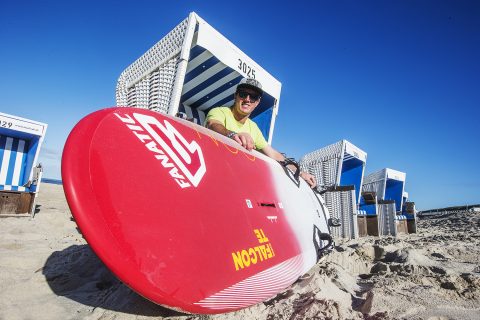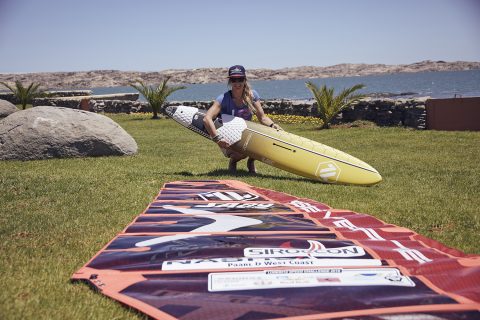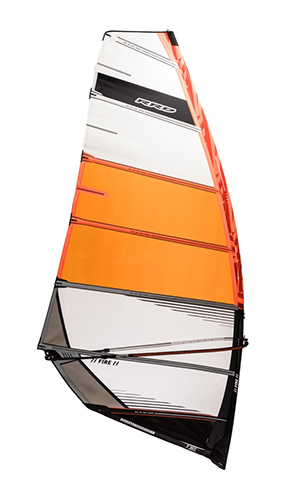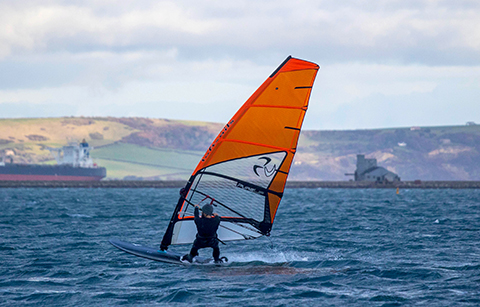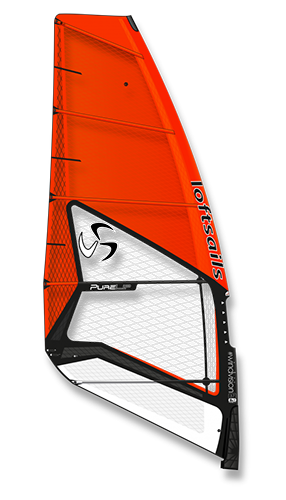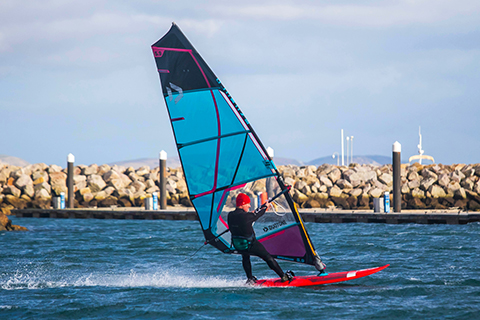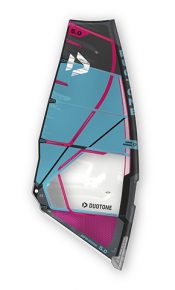Outdoor sports, Extreme sports, Running, Triathlon, Mountain bike, Kitesurf, Windsurf, etc...
martes, 30 de junio de 2020
OWEN WRIGHT talks about his PERFECT HEAT and WINNING the 2015 Fiji Pro | The Lineup: REARVIEW
In The Heat Of The Winter - Bouldering In Alcañiz | Climbing Nomads
Riding Historic Wooden Boards in MADAGASCAR | Brilliant Corners - Episode 1 Chapter 2
lunes, 29 de junio de 2020
Filipe Toledo Defeats Julian Wilson to WIN His FIRST CT Event @ '15 Snapper Rocks FULL HEAT REPLAY
"50k Trail Run Race Changed My Life Forever" - Mira Rai, Nepal | The Way Of The Wildcard
#Windsurf MARCO LANG: TESTING TIMES!
MARCO LANG: TESTING TIMES!

Windsurf Magazine catch up with Duotone chief sail tester Marco Lang for an update on his season so far:
Photos: PWA/ Carter
WS: What have you been up to over the past few months?
ML: As every year I spent two months on Tenerife for training and preparation for the upcoming season. The same time I developed new products together with Duotone Chief Sail designer, Kai Hopf. In March, I went to south of France for the final preparation with Pierre Mortefon, but then I left just before the lockdown. Since that I have been back home in Austria!

WS: Have you been able to sail?
ML: Austria was really strict with their rules since the beginning of the lockdown in Europe. So, after two weeks of quarantine at home, I could sail again on my home lake. It´s not the windiest spot, but I was happy to be out in the fresh air. I kept everything pretty secret, because I knew few other PWA Sailors were fully lockdown at home under stricter rules.

WS: Are you still training the same for PWA events or are you taking a break?
ML: I never stopped training, I want to stay strong in my mind and don´t lose the motivation for testing and competition when it returns.
WS: What is your role for Fanatic and Duotone?
ML: I am Chief Tester for Duotone Windsurfing and I am always trying to help the Fanatic guys as much as I can with the development of their boards.
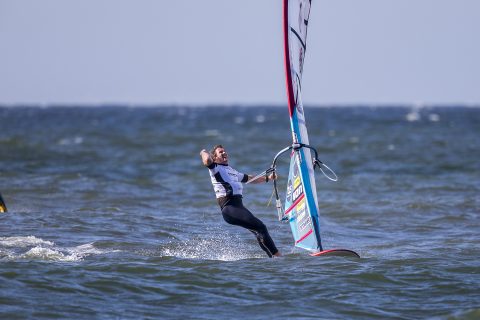
WS: What is the highlight of your career so far and why?
ML: It´s still my Victory on Sylt! I hope I can repeat that moment, but now I am more focusing on Product developing than being an out and out racer.
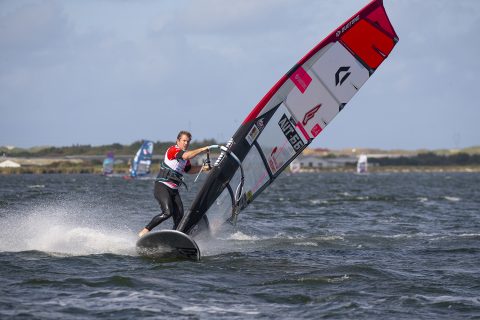
WS: What do you love about racing?
ML: The speed we reach really gives me an adrenalin kick!
WS: Where do you see yourself in ten years-time?
ML: Hopefully still working for the Windsurfing industry.

WS: What does it take to win a PWA event or round of slalom?
ML: A lot of ambition combined with a bit of luck.

WS: How do you like foiling compared to slalom?
ML: The last weeks I could catch up with a lot of foiling and I have really started to love that feeling in the light wind. In light gusty conditions you become really frustrated with fin equipment, but with the foil you don´t care as you glide through the lulls.
WS: Are you looking forward to the new slalom/ foil racing formats when PWA racing resumes?
ML: I still don´t know what I should think about it. It´s something new which nobody has seen before, but one thing for sure, I will be 100% prepared!
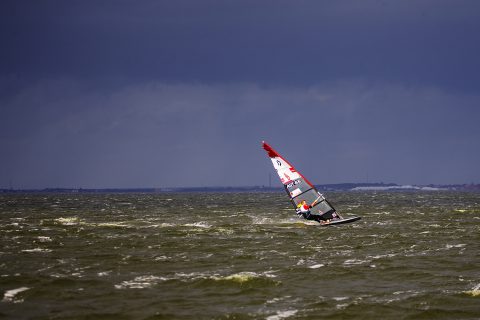
WS: Do you enjoy the testing side of windsurfing?
ML: Since my beginning of my windsurfing career it was my goal to work for a windsurfing brand. Pretty soon I met Kai Hopf for the first time and from the first moment, I was addicted to developing products. Getting great feedback from customers almost feels as good as winning an event to me these days.

The post MARCO LANG: TESTING TIMES! appeared first on Windsurf Magazine.
Windsurf Magazine https://ift.tt/2BK7IuKdomingo, 28 de junio de 2020
Searching for Surf in MADAGASCAR | Brilliant Corners - Episode 1 Chapter 1
sábado, 27 de junio de 2020
#Windsurf ADAM WARCHOL: SOUTH SWELL MAUI
ADAM WARCHOL: SOUTH SWELL MAUI
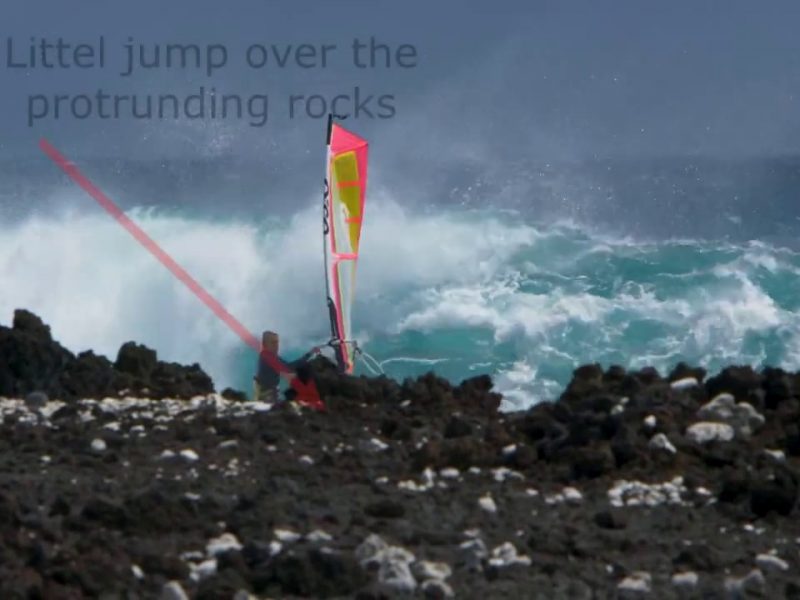
Goya team rider Adam Warchol who is from Warsaw in Poland was out in Maui when the lockdown hit and has been making the most of the south swell season riding in front of rocks at La Perouse Bay!
Via Adam Warchol
The post ADAM WARCHOL: SOUTH SWELL MAUI appeared first on Windsurf Magazine.
Windsurf Magazine https://ift.tt/2VGAMdVAll the BEST Surfing 2015 Gold Coast Pro ft Filipe Toledo, Carissa Moore, Julian Wilson, John John
#Windsurf SPEEDY RECOVERY: KARO VAN TONDER, LUDERITZ
SPEEDY RECOVERY: KARO VAN TONDER, LUDERITZ
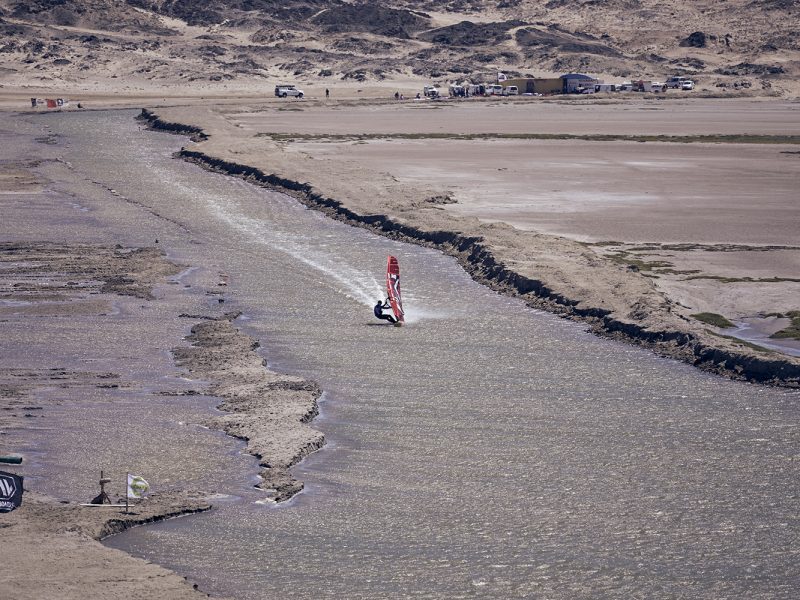
Karo Van Tonder suffered a serious shoulder injury at 2018’s Lüderitz Speed Challenge that required surgery. Far from setting her back however, she set her sights on entering the 2019 Lüderitz Speed Challenge! Karo tells us more about her accident and inspiring comeback journey.
Photos: Stefan Csáky and Karo Van Tonder
PAIN
Lying in hospital with excruciating pain after my shoulder operation, I had zero mobility in my shoulder. The dislocation happened as result of a freak accident the previous year at Lüderitz. I was standing in the stop area, absolutely exhausted from the physical input it required to break my African record during my last run. As I was holding tight onto my gear, a monster gust ripped my sail from under my arm with great force, causing it to fly miles away and left me with a severely dislocated shoulder. Due to the impact, my entire labrum was torn off, ligaments ripped and bone damaged. Fortunately my dad is a doctor and he was able to pull my shoulder back in place within 15 minutes after the accident – those were the most painful moments of my life. At first we decided to let it heal by itself, but due to the high level of instability, it dislocated again while doing normal daily life activities and I had to get it operated on.
REHAB
After the operation, I was restricted to wearing a sling 24/7 for a month, which left me with only 3 months to prepare for the 2019 Lüdertiz Speed Challenge. For a windsurf addict like me this was a nightmare. The orthopaedic surgeon said it would take 18 months to grow together again 100%, and until that time I would have a great risk for dislocation again, range of motion limitations and limited workload allowance. Regardless, I decided to stay positive and put in everything I had to prepare for the world speed record. Dedicated and determined, I started with my physiotherapy a day after my operation. After a month I was freed from the sling. I had lost all of my fitness and strength and could barely lift up my arm. Every day I spent a minimum of 3 hours doing rehabilitation training. After three months of intensive work and the help of my physiotherapist and biokineticist, I managed to get my shoulder mobility back just in time. Being so limited in strength, I knew that my sailing technique would have to be up to the highest possible level on the channel.
EQUIPPED
When going down that narrow, shallow canal at such high speeds in winds so strong they make rocks fly through the air, there is no better thing than knowing you can rely 200% on your gear. I was provided with a custom made AV 37 cm wide speed board, shaped by my new board sponsor, Aurelio Verdi, a legend in the board shaping world. Severne made a custom 5.0 speed sail for me and Gasoil fins provided me with a pair of neatly shaped speed fins. My kit was all ready to go for it!

A CHALLENGE
Lüderitz is situated along the southwest coast of Namibia. This little quaint town experiences some of the most brutal wind conditions in the world and is therefore the perfect location to set world speed records. Windsurfers from all over the world come to push their limits on the man-made canal, which is about 7 metres wide and 40 cm deep! The town and landscapes literally look like the moon… rocky hills and sandy dunes with the odd succulent plant here and there. Being the lightest and youngest this year, getting back onto the canal in the middle of the desert with winds gusting over 50 knots was, on its own, a big mental challenge for me. The most valuable skill that one can have is the ability to keep yourself calm and collected so that you are able to make quick, rational decisions. Listening to music before I went on the canal each day helped calm my nerves by shutting out the harsh sound of the wind. The most priceless aspect for me this year was having my dad with me. When operating in these winds from the morning to afternoon non-stop, there is no better thing than having someone who helps you to rig, hands you bananas and coke while you sit in the starting box and helps you make quick gear changes when the wind changes. A big bonus is that he is also my doctor in case things go wrong. I wanted to continue my journey from where I left off last year at 41.3 knots with a dislocated shoulder; there was unfinished business.
STARTING TECHNIQUE
My first priority was to return in one piece and secondly, to improve my African speed record, even if only by half a knot. On day one I got into things very smoothly and was stoked that I managed to waterstart the smallest board I’ve ever sailed, a 43 litre AV speed board that was 37 cm wide. The waterstarts at Lüderitz can be one of the most difficult skills to master, but it is also the most important aspect that determines your average speed down the canal. A perfect start leads to a high entry speed that gives you enough momentum to maintain it through the lulls. There are two types of starts on the canal: ‘water starting’ and ‘jump starting’. Personally I prefer the ‘water start’, because, being very light, the wind can gradually lift my sail and I up and I have control over how much wind I allow under my sail at the right moment as I lift it up. When ‘jump starting’ in very strong winds the gust hits your sail full on and you go from zero to maximum power in the sail in split seconds. This is a lot of instant power to manage for someone my size and the risk of getting tossed right over the front is high. For the bigger guys, the ‘jump start’ is definitely the preferred method, because they can do a forward motion push before jumping on, creating momentum to the front that is just enough to carry them through all the motions of getting feet in the straps and hooking in without sinking and crashing their fins. However, when the wind gets really nuclear, even they prefer doing water starts. Whether ‘water starting’ or ‘jump starting’, the challenge is to be as light as possible on your feet, to prevent sinking in the lulls and hitting your fin on the bottom of the shallow canal.

WEIGHT MATTERS
Just imagine being loaded with a 10 kg lead weight and getting up on such a narrow board in winds gusting 50 knots! Your timing is crucial. The more speed you have before you hit the slingshot, the safer you are down the line. It’s almost like running away from a lion that’s chasing you – you need to hit the corner at a high enough speed so that the first monster gust don’t throw you off from behind. When water starting, you have the advantage of being in the straps from the word go and you don’t have to hop around on the board while managing the heavy gusts to get your feet into the straps. Any tiny movement of your feet on such a small board can have a huge effect on how it behaves, which makes this kind of water start a lot more technical than a normal one on open waters with a big slalom board. When I’m on the plane, I always aim to pitch as high as possible onto the upwind bank just before the turn. This way I can make a very sharp downwind turn, throw my bodyweight backwards and sheet in as hard as possible to harness the first gust on the slingshot. This motion provided me with insane acceleration around the corner so that I am fast enough to manage the heavy gusts going downwind, as well as maintain high speed through the lulls. The more weight you have on you, the more momentum you have and the higher the speed you will be able to maintain through the lulls. The additional weight also helps to keep the board down and your body stable through the gusts.
CONFIDENCE
Run by run, I built up my confidence and effortlessly consistently hit 40 knots average. Previously, hitting 40 knots was like reaching the top of Mount Everest! Every day I tried to do as many runs as possible in order to hit the perfect window of wind. My strategy was to stay on the same board, sail and fin and only change lead weight – thereby becoming fully tuned into my gear. I consistently used 5 kg lead in my impact vest on practice days to train myself to waterstart and operate with it like it was part of my body. Going down the channel I tried to keep my position locked all the way down without relying on my arms. I pressed as hard as I could onto the fin for acceleration, pushed my entire body out over the side of my board and hung completely into my waist harness – my hands just there to make tiny adjustments to the sail when gusts would hit. Contrary to mainstream speed sailing technique and styles, I used short 24 cm harness lines. In doing so, my arms were more bent and I had a lot more power and control in my muscles at this angle than with straight arms.

TACTICS
Because of my shoulder injury I needed to find a way to waterstart without relying too much on my arms or shoulder and conditioned myself to lift up effortlessly from a position in the water, lying completely hooked in and feet in the straps. I perfected this manoeuvre and allowed the wind to do the work without too much strain on my shoulder. I believe my wave sailing skills (thanks to my wave teacher husband, Charl) contributed greatly to my skills in the starting block this year and gave me a good balance, mobility and “light feet” to manage the small board with the added lead weight in shallow waters.
I aimed to stay centered going down the channel to give myself space to go a little upwind during a lull and maintain power in my sail all the way down. Your maximum speed is not at all considered in this discipline, it’s the average speed over 500 metres that is the most important and therefore you need to be able to maintain a high speed throughout the lulls.
Being light it’s a big challenge to use all my body weight to push down on my sail as hard as I possibly could onto the water during my downwind 360 degree turn in the finishing block. 30% of the time I was just not heavy enough to put the sail down all the way and it ended up catching a massive gust of wind and flying over my head – almost ending up looking like a freestyle move! If you let go of your gear at this point, it will fly many miles away. Some days it was so choppy in the finishing block that I severely hurt my ankle ligaments by over-flexing as I bounced off the chop leaning forward in my finishing carve. The finishing block gets very shallow very soon. With so little room for error, guys have crashed their boards (and themselves) into pieces.
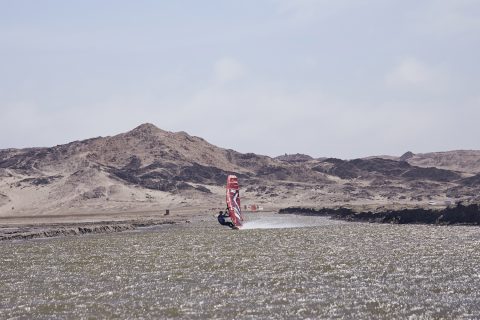
TUNING
We used the same medical strapping my dad put on my shoulder everyday to keep it in place to also cover my boom. This gave an insane amount of grip, though a very expensive operation ha ha! There is absolutely no better boom grip than medical bandages!
This year I had less downhaul on the sail, because I found that this can kill the sail’s profile. My Severne Mach3 speed sail was perfectly designed, with a tremendously deep profile and a lot of twist. The best part was that it rigged perfectly as is from the bag – no adjustments needed. The sail gave me the perfect amount of back vs front hand pressure. If a sail has too little back hand pressure it can easily throw you forward when a gust hits. Gunnar Asmussen showed us how to put in leech tension by pulling the leech line right at the top of the sail towards the mast and making a knot to give the sail even more power. I had my outhaul just loose enough to touch the boom slightly. I prefer using a double-sided boom because it helps to support the sail and maintain its shape. When using one-sided booms there is no support for the sail when over-bagging it past its original shape. This can completely change the dynamics of the sail from what it was meant to be.
The 5.0 was built to rig with a 400 RDM mast, but I used a 370 RDM mast to get maximum softness and flex, allowing the sail to take in the gusts like a shock absorber. When sticking with what I’m familiar with, I have a lot more confidence, control and speed, therefore I used my waist harness at Lüdertiz.
With my boom at its lowest point, my body had a perfect angle to my sail and plenty of leverage over the board to stay low. I learnt to take advice from so many amazing speed legends, but at the end of the day I only used what felt good for me and what worked for my body. Someone double my weight and length might have a completely different setup than me and that is just physics!
My new AV speed board was a total game changer for me and flew over the water with a perfect amount of lift from the front, minimising drag. My sweet spot for fin size was 18.5 cm. When using a smaller fin I had too little lift. As soon as I put in a slightly larger fin I gained more lift from the back and the board levelled out perfectly. I also learned from Vincent Valkanaers that the bigger the fin you are able to use, the better you will be able to maintain your speed and momentum through the lulls. It’s quite an amazing feeling after the acceleration, when you reach top speeds going down the channel, how speed kit really kicks into “sport” mode. It’s like driving a race car, everything just feels better the faster you go! At top speeds the apparent wind became so severe that it caused a funny vibration to go through the sail and a very low tone humming sound. When a gust hits and you manage to lock it perfectly you gain so much acceleration that you outrun the speed of the wind and experience some wind from the front. Whenever I heard this sound going down the course I knew I was in business!
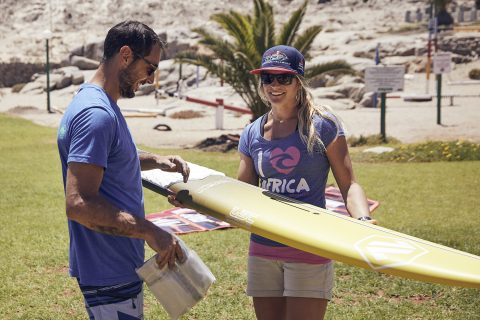
RECORD BREAKING
The record breaking day had arrived. My dad, the optimist that he is, smiled that morning and said, “Hmm I better put on my best shirt for the record breaking interview today”. I laughed and then put on my waterproof lipstick for the same reason. There is nothing better than to have someone with you who so solidly believes in what you are able to achieve, it gave me so much confidence entering this day. Like all the other days on the channel I was the first one to start doing runs. My starts were spotless. Being very light, it was important for me to be on the channel early enough to catch the perfect wind window that is the ideal direction and strength for me to go fast while still being in control of my gear. I found every knot above 40 is extremely hard work to reach. At midday I finally got stuck on 42.8 knots for several runs and was steadily running out of mental, emotional and physical energy. As I was waiting in the line for my next run the wind had picked up to 45 knots, gusting 50 knots. My dad helped me increase my lead weight to 10 kg and then I told him: “I am going to break my record in this next run.” I just knew I had to do it there and then with all the last bit of power left within me. By this time the wind started blowing little rocks and sand over the channel. It would be the strongest winds I have ever taken on in my life with a 5.0 sail. I went into the starting block and sat there holding my sail stable, waiting for my green flag. I took a deep breath and waited for a lull to attempt my start, because the gusts were, at this point, too strong for me to start in. The moment I got up I pushed extremely hard to get to the highest possible speed I could before the first monster gust would hit me at the slingshot.
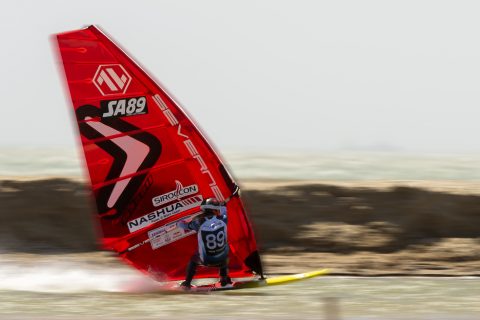
ACCELERATION
The acceleration was intense, an indescribable adrenaline rush. I managed to stay locked down and focussed. It felt like as if I was flying down the channel, barely touching the surface of the water. Everything felt in harmony: my sail, board, fin and my body as a huge amount of force went through it all. I heard that vibration sound again, but this time, it carried on right through till the end of my run and I knew something big had just went down. As I came to a halt, my friend Anne from Spain had just broken her ankle trying to stop and she was helped out of the water at that point. As I approached the trailer I glimpsed down onto my GPS, knowing that, regardless of what it says, I had reached the end of my physical and mental abilities.
It went like a shockwave through my tired body when I saw 44.55 knots on my screen. As I reached the start my dad had his arms up and was running towards me… “44.55 knots!!….. INSANE!!” I wanted to celebrate with him, but not being able to come to terms with it yet, I sat there on the ground next to the channel in tears with absolute pure relief that everything I had worked so hard for and for so long had just paid off in a much bigger way than I could have possibly imagined. Being two knots away from the world speed record, the 5th fastest woman in the world and still in one piece was for me like hitting the jackpot. So there we were, my dad in his best T-shirt and me with my waterproof lipstick still intact after all the sandblasting, having a record breaking interview with Raffi (Raffaello Gardelli the event organiser), who also tried to stay calm from the excitement. This moment was absolutely priceless.
LESSONS
Through my experiences this year, the biggest lesson I’ve learnt is to not let a major setback become a stop sign. Pick yourself up, dust yourself off and go at it again with full force and with a greater amount of inner strength, wisdom and knowledge. The difficult times are what shapes and builds us into stronger humans so we can take on bigger challenges – physical challenges, mental challenges and emotional challenges. This event tests all three of those to the maximum limit. I believe our world and sport today can benefit a lot more from people with good sportsmanship and integrity than people with big titles. This has been and will always remain my biggest priority: promoting my love and passion for this amazing sport and sharing it with the rest of the world.

THANKS
I would like to thank Raffaello Gardelli for his amazing work in making this event a world-class experience and turning it into something speed dreams are made of. Thank you to each and every speed legend at the event, my family and followers for all the amazing support (Charl van Tonder, Heidi Ulrich, Louis Naude, Anne Schindler, Aurelio Verdi, Alberto Possati, Gunnar Asmussen, Twan Verseput, Vincent Valkenaers, Carsten Frank, Farrel O’Shea, Pep Bonnet, Stefan Csaky…the list goes on). A big thanks to Severne Sails for all the expertise that goes into making these powerhouse custom sails and to my new board sponsor, AV Boards, for shaping me the fastest little speed board! Gasoil fins, thank you for the awesome fins!
Lastly, to my dad, it is priceless to have someone who knows my sailing abilities, my limits, my fears and my emotions off by heart. We have been together through all the highs and lows. My dad and my husband have both been fundamental in each and every achievement I have made in my windsurf journey so far. My dad has a big heart and absolute devotion to helping those around him, being the spirit of the crowd and paving such a smooth, wide open and safe road for me to walk on with confidence. We are a team and, regardless of the result or records broken, we will always remain a winning team.
The post SPEEDY RECOVERY: KARO VAN TONDER, LUDERITZ appeared first on Windsurf Magazine.
Windsurf Magazine https://ift.tt/2VnPypujueves, 25 de junio de 2020
#Windsurf 6.0M CROSSOVER SAIL TEST 2020
6.0M CROSSOVER SAIL TEST 2020

ALL WEATHER DRIVE –
6.0M CROSSOVER SAIL TEST 2020
Test Editor Tris Best // Second Testers Maurin Rottenwalter, Joe North & Dan Hallam
Photos Team Newwave //
Test location Portland Harbour and Overcombe.This test was originally published in the April 2020 issue of Windsurf Magazine.
FINDINGS
Sitting next to wave sails in most brands’ lineups; the crossover sail could be classed as the first category that is primarily focussed around the recreational sailor. Whereas wave sails are designed to meet the demands of the world’s elite (and rigours of the most challenging conditions), the crossover sail is developed by brands with the consumer market in mind, and as a result the priorities of the design brief can be very different. Practicality of rig and set, wind range and handling ease are probably the main goals here; hassle-free sailing that will flatter the rider and keep them coming back for more. That said, some brands have consciously taken the decision to omit a ‘crossover’ focussed category, perceiving it as an unnecessary ‘dumbing down’ exercise, patronising the consumer. Their argument is that the requirements and demands of both the recreational sailor and the pro are synonymous, so the obvious choice for this category is the 5-batten wave sail. And we have a few included here.
All the sails on review here adopt a 5-batten structure and all set on 430 cm masts, (even the ‘foldable’ RRD). The feel most are aiming for is soft and smooth, combined with easy handling and range, which means most have a forward focussed centre of effort. In pushing the draft forwards, the tension and luff curve required to lock the stability in place can be reduced, breathing more life and connection with the mast into the sail and more bottom end response as a result. If the remit is for a manoeuvre-oriented feel, then the sweet spot tends to be focussed higher in the draft; if it’s more freeride in nature then the sweet spot is dropped lower towards the sail’s tack. There are a couple of sails in this test group that purport a different feel and proposition, shifting the draft back to sit around the rider. In doing so, they bring a different feel and balance, as well as power management – something that will undoubtedly find favour with the more assertive and adventurous. And as with last year, there is an ever-increasing shift in the wind foiling world towards manoeuvre-oriented, recreational freeride foiling, expanding wind ranges and enjoyment possibilities. Some of these sails make simply stunning kick-start engines for a foiling setup, in addition to their main marketed briefs. If you’re foiling as well, or looking to get into it, this has got to be a consideration in choosing your new sail.
SUMMARY
Let’s start with the wave sails amongst the group and the Purelip from Loftsails is somewhat of a brand foundation, having been in its range for the last 20 years. It has near legendary status when it comes to top end handling and control, and this year is no exception. The Wave from Ezzy extends up to 5.8m, gaining a batten yet losing none of its incredible range and new-found light-weight handling or response. The Atlas makes a return to Neil Pryde’s ranks too, and becomes a platform to exhibit the brand’s reputed scrim laminates. It has the looks, the handling … and potentially the price tag if you want to go all out! There are then several sails in the group that undoubtedly have more focus on straight-line / flat water work. The Hybrid from GA Sails is long in boom and super easy in nature, asking to be locked in for some long-distance freeride cruising. Severne’s Gator takes light-weight handling to another level. A sail that is so effortless and user-friendly that it practically sails itself, accelerating in gusts and pulling almost magically through lulls. The Simmer Enduro and Goya Nexus both offer a different proposition, focussing the draft position around the rider for more obvious feedback and response. The Simmer has a softer delivery and is incredibly balanced; the Nexus is tight like a drum and gives that extra little something to play with and explore through the back hand. The Compact Fire from RRD has its roots firmly planted in the straight-line/freerace quarters and is a match for any here when properly powered. Its USP is obvious and should be commended; in times when it is becoming increasingly hard to travel with kit on flights, this could be a genuine solution. And best of all, performance is no longer the trade-off. So onto the all-rounders; the ones with their feet in both camps – flat-water and coastal / waves. The Super Session from Duotone has a cleaner, more eye-catching graphic for 2020, and has a very connected and enjoyable character. The Torro from Gunsails uses conventional dependable materials and shaping-techniques to produce a sail that everyone got on with. There is nothing innovative or pioneering about it, but it comes at a price that should rightly make many stand up and take note. That leaves the Spy from Point-7, a sail that has been re-branded and re-defined verbally by its creators several times in recent years, but for good reason; it is so universally liked and capable that it is hard to describe succinctly!
uk.otc-windsurf.com
THE LINE UP
The post 6.0M CROSSOVER SAIL TEST 2020 appeared first on Windsurf Magazine.
Windsurf Magazine https://ift.tt/2BbwKD8#Windsurf RRD COMPACT FIRE 5.7M 2020 TEST REVIEW
RRD COMPACT FIRE 5.7M 2020 TEST REVIEW

RRD COMPACT FIRE 5.7M
2020 TEST REVIEW
THE VERDICT
With powered performance assured, the Compact Fire extends the boundaries of what is conceivably possible for a foldable sail. It is not cheap and the uniqueness of the concept adds to the additional cost of the rig. Yet what price do you put on the exciting practicality of carrying a complete rig in a backpack, and the doors to adventures it can unlock? Will other brands follow? We’re sold … so we think they should!
OVERVIEW
This is the third opportunity we have had to test RRD’s unique and pioneering Compact Rig concept, having tried the Compact Freefoil back in 2019 and the Compact Vogue earlier this year in the Jan-Feb issue. The industry has flirted with the idea of ‘foldable sails’ several times in the past, but nothing worthy of note has ever amounted from it, largely down to their compromised performance. Fast forward to 2020 and RRD are now confident they have cracked this tough nut. The amount of energy and investment the brand (and their sail designer John Skye), has made in the concept is clear to see, with a total of six ranges now in the series, from the Vogue wave sail to the foiling Freefoil, and two freeride numbers (including this Fire), a youth targeted Grom lineup and wind-sup specific engine. This Compact Fire is their ‘performance freeride’ engine, sitting next to the ‘easy freeride’ X-tra, and comes in four sizes from 5.0m to 6.8m. All four sizes are designed for use with the Compact Freeride Rig Pack, which itself is available in either PRO or HD format, the main difference (amongst other niceties) being the high-priced collapsible carbon boom in the PRO package. RRD go on to state the Compact sails also work with standard components, so that the initial outlay can be broken down into more palatable staged payments. Easy to understand and rig, the fact that the Fire is put together from a folded start adds relatively little to the rigging time, albeit the most time-consuming process is fixing and taping the mast together so that it doesn’t pull apart whilst tensioning the downhaul. The battens are intuitive to assemble and engage, thanks to the new batten tensioners, whilst the folding and rolling process becomes easier with practice. Once set according to the trim-guide in the upper panel, the Compact Fire displays a moderate amount of luff curve, retaining good rotation in the bottom two battens, the leech falling away significantly in the top two panels. With a focus on optimising the sail’s strength to weight ratio, monofilm is used in all bar the foot and clew panels, where polyester x-ply is adopted. And with RRD’s 25-year celebratory colour scheme, the obligatory Dacron stripe through the middle of the sail doesn’t look unsightly, intersected by two load bearing tendons radiating from the clew to control the stretch experienced in the main panel.
BRAND CLAIM
“Our top performance freeride sail, available as a Compact Series sail. All the winning performance of the original Fire, but can be folded into a backpack with 2 other sails, to make a dream portable quiver. The future of performance portability.”
PERFORMANCE
Set for light winds using the upper eyelet of the sail’s ‘Power-Clew’ system, the Compact Fire is easy and balanced at rest, the extra reinforcements required in the component parts making no tangible difference to the physical weight of the sail on the water. The one difference we did notice was the mast’s response to assertive pumping. Being a 370 cm (albeit with a 60 cm extension), it did feel softer than others on test, providing less bottom end punch or spring when trying to force the issue. That said, the Fire’s passive planing threshold is still respectable, pulling positively as the wind increases and pressure builds. The centre of effort is located low and forwards in the draft, channelling power efficiently to the board and almost bypassing the rider as it remains light and focussed in the hands. To this end, this is where we feel the Fire’s true pedigree begins to shine through, the performance heritage of its namesake rising to the surface. Once properly powered, the Fire is a match for most here in a straight-line. Its acceleration during gusts is palpable, feeling lighter and even more positive as it pins the board to the water. Locked in and charging, it is an easy sail to get on with, requiring little rider input yet bringing a smile to their face. The extra tuning range available through downhaul and the lower inset eyelet enhances the Fire’s range further, whilst in transition its low down drive position makes it smooth in rotation and easy to manage throughout.
www.robertoriccidesigns.com
VITAL STATS
Size: 5.7
Luff: 435 cm
Boom: 183 or 188
Battens: 5
Ideal Mast: RRD Compact Freeride Rig (370 cm + 60 cm)
Available Sizes: 5.0, 5.7, 6.3, 6.8
Price: £718 FREERIDE RIG PACK £871
Other sails in this test:
THE LINE UP
The post RRD COMPACT FIRE 5.7M 2020 TEST REVIEW appeared first on Windsurf Magazine.
Windsurf Magazine https://ift.tt/2BcV4V1#Windsurf LOFTSAILS PURELIP 5.7M 2020 TEST REVIEW
LOFTSAILS PURELIP 5.7M 2020 TEST REVIEW
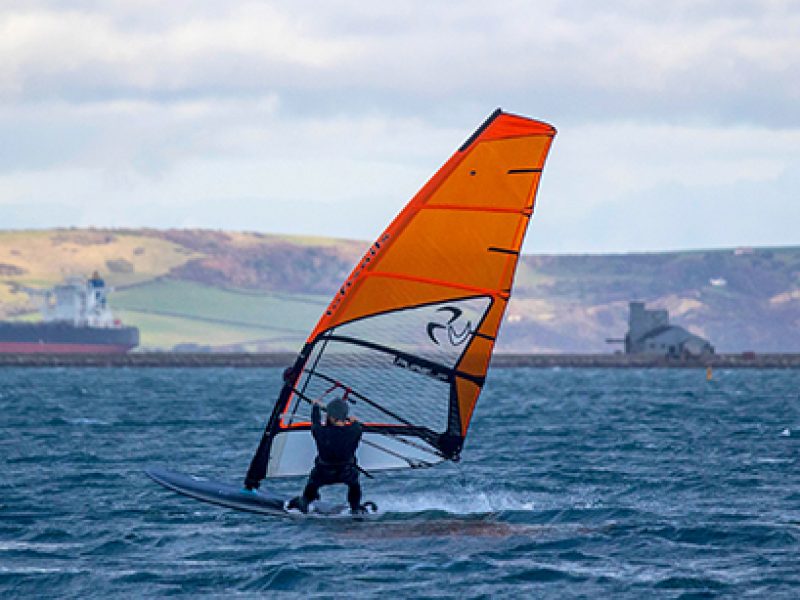
LOFTSAILS PURELIP 5.7M
2020 TEST REVIEW
THE VERDICT
Large in outline but feeling small and perfectly formed in the hands, the Purelip is a sail that will have your back, no matter how extreme the wind or environment.
OVERVIEW
The Purelip is Loftsails’ signature ‘hardcore wave’ sail, its roots dating back to 1999 and the original Lipwave design. Available in two distinct green or orange colourways, the range stems from 3.0 to 6.2, with all bar the two smallest sizes featuring a five batten configuration. Tested on a Team Edition RDM (yet still applicable with an SDM), the mast is easy to sheath up the brand’s durable IYU250 4-part luff sleeve, the tack fairing fully opening up along an extended Velcro edge to provide full access to the roller pulley. And with the pulley oriented for maximum efficiency, it was easy to apply the moderate downhaul tension required, loosening the leech to the trim marker in the upper panel. There is plenty of skin tension throughout the sail’s panels, the leech falling away along its length whilst the two lower battens sit clear of the mast at rest. Build quality is excellent, as we have come to expect from Loftsails, with all their trademark concepts in place. From their Integrated Panel System (IPS – providing triple-layered radials at the sail’s main tension-junctions) for durability, to the use of their exclusive ‘Standing Battens’ for stability and response, and even the double Dacron head panel for roll-up longevity, the Purelip continues to exude its flagship status for all of Loftsails’
pioneering features.
BRAND CLAIM
“Tarifa’s famous nuclear winds and 18 years developing curves produced the Purelip design concept… easy animation for hardcore conditions!” – Monty Spindler.
PERFORMANCE
Whilst still compatible with SDM, the Wavescape was supplied with a 400 cm Team Edition RDM for testing. Rigging is straightforward, the tack roller oriented in line with the extension’s rollers for easy downhauling. Rigging to achieve the looseness specified by the trim marker in the upper panel, the battens sit very flat and neutral at rest, with only the main batten above the boom retaining rotation, and just the slightest hint of shape in the bottom batten. On the water the Wavescape has a unique nature. Light and balanced in the hands at rest, its dimensions make you feel that you have a large sail in your hands, yet it performs and manoeuvres as you’d expect of a much smaller sail. Flat and neutral initially, it responds well to pumping and takes shape as pressure builds, the movement in the Dacron luff panel complimented with plenty of excess material in the luff sleeve. Power delivery is smooth and comfortable, the Wavescape accelerating positively, whilst feeling balanced in both hands, delivering energy efficiently to the board. In gusty conditions it twists and maintains forward drive, and whilst we did experience a little leech flutter, there certainly wasn’t any control issues. Fast and controllable on the way out, the Wavescape was a real gem to use on the wave too, providing the settled dependable power to tap into before going magically neutral and weightless as it is eased out. It encourages the rider to really play the boom and make use of the power available. And as with all Loftsails we’ve used recently, when the conditions increase you can relax in the knowledge that the sail’s natural range and top end stability are there, using the lower clew eyelet to encourage a more compact stance and relying on the sail to keep the board in check.
VITAL STATS
Size: 5.7m
Luff: 452 cm
Boom: 180 cm
Battens: 5
Ideal Mast: Team Edition 430 cm RDM/SDM
Available Sizes: 3.0,3.4,3.7,4.0,4.2,4.5,4.7, 5.0,5.2,5.4,5.7,6.
Price: £665
Other sails in this test:
THE LINE UP
The post LOFTSAILS PURELIP 5.7M 2020 TEST REVIEW appeared first on Windsurf Magazine.
Windsurf Magazine https://ift.tt/2Vk22yl#Windsurf DUOTONE SUPER SESSION 5.9M 2020 TEST REVIEW
DUOTONE SUPER SESSION 5.9M 2020 TEST REVIEW
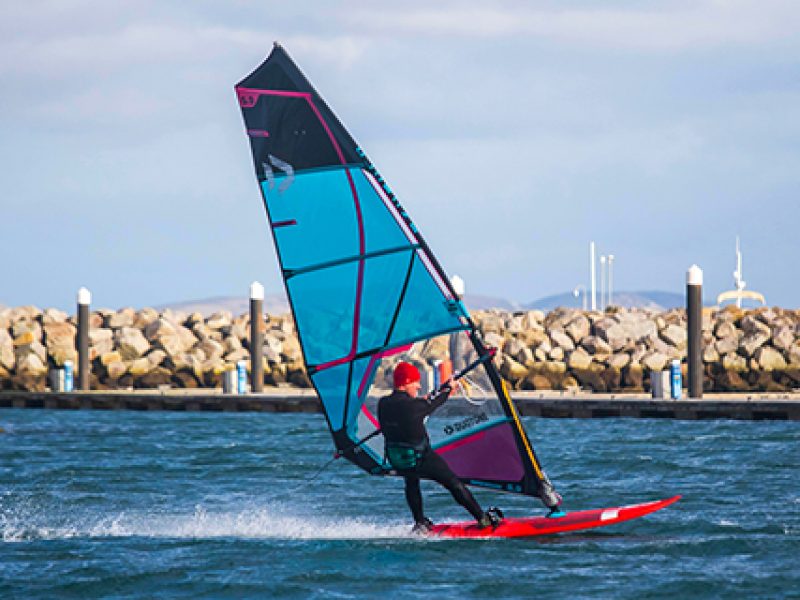
DUOTONE SUPER SESSIONS 5.9M
2020 TEST REVIEW
THE VERDICT
Retaining its rider-focussed pull position, there’s real crispness and precision to the 2020 Duotone Super Hero’s handling, which combined with a super smooth and dynamic power delivery, makes it a doyen of the wave riding arena.
OVERVIEW
Duotone describe the Super Session as the ideal engine to partner ‘freewave and small freeride boards’, with the versatility to mix it between flat water and waves. Sitting next to the Super Hero in the Duotone range, the brand is quick to highlight the differences between the two, namely the draft position of each. So whilst the Super Hero has its centre of effort located low and back, around the rider for crisp neutral handling, the Super Session’s power is located higher and further forward in its profile. The end result is a sail said to have very different mannerisms – generating lift for early planing, whilst feeling light, crisp and direct in nature. Duotone have gone to town on their website to help their clientele decipher which sensation is best for them, even listing the compatibility of the other brands’ masts and sails in a quiver! It is a very honest approach and, in our opinion, should be commended, informing the consumer as best as possible. Rigged here on a Platinum 430 cm RDM, the Super Session is easy to downhaul, requiring little tension to achieve leech looseness within the prescribed VTS (Visual Trim System) markings (said to have been increased in sizes 5.6 and above for more control). The hollow leech scoop remains evident just above the clew, and the Super Session continues to feature the brand’s concept of pre-tensioned battens, where the sail is ready to go, straight out of the bag. The principle of the concept is to mitigate human error on the rider’s part … yet we really struggle to resist the temptation of using the new torx key to tension the lower two battens at the very least, what with all the crinkles along the length of the batten pocket. Tested here in standard construction, with x-ply foot and clew panels, and monofilm luff and upper panels, the Super Session is also available in an HD construction, using x-ply throughout. One final note – the sizes available in the Super Session range have swelled significantly for 2020, with ten now available from 4.0 to 6.7, ensuring its compatibility for most quivers.
BRAND CLAIM
“Freewave boards are amongst the best selling on the market. The SUPER SESSION has been developed specifically for this category.”
PERFORMANCE
Using the Super Session in light marginal conditions, it has a very light and ‘pumpable’ nature, where the rider has a true sense of feel and connection with the mast. As pressure builds in a gust, the feedback comes through both hands, and a well-timed pump generates a real spring and surge forward. It’s as if the whole sail with all its panels are in use and geared towards getting you on the plane. Once going the sail quickly settles into a comfortable stance, sort of halfway house between upright and locked in, where it can adapt to various riding styles. Power delivery is smooth and balanced, its high and forward position generating good lift without pulling the rider out of shape or to their toes during gusts. Instead, it has a light and forgiving nature, encouraging them to enter transitions actively and positively, before going neutral and airy as it is sheeted out. More manoeuvre-oriented in nature than blasting, it has both natural and tuning range, which can be put to great use as the wind increases, settling any rearward movement in the draft. And given its easy handling, forward facing drive and ‘pumpable’ bottom end, the Super Session remains an excellent exponent for entry/freeride foiling too.
VITAL STATS
Size: 5.9
Luff: 443 cm
Boom: 179 cm
Battens: 5
Ideal Mast: Duotone 430 cm RDM
Available Sizes: 4.0,4.2,4.5,4.7,5.0,5.3,5.6,5.9, 6.3,6.7
Price: £609 HD £659
Other sails in this test:
THE LINE UP
The post DUOTONE SUPER SESSION 5.9M 2020 TEST REVIEW appeared first on Windsurf Magazine.
Windsurf Magazine https://ift.tt/31lzAQy#Windsurf SEVERNE GATOR 5.7M 2020 TEST REVIEW
SEVERNE GATOR 5.7M 2020 TEST REVIEW

SEVERNE GATOR 5.7M
2020 TEST REVIEW
THE VERDICT
Carefree sailing at its best, the Gator pulls through lulls and accelerates in gusts, whilst maintaining its featherlight handling at all times. It demonstrates just how hassle free a freeride sail can truly be.

OVERVIEW
The Gator remains in the Severne lineup for 2020 as their freeride crossover option, progressing through 14 sizes from a wave / high-wind bump-and-jump sail to a low-cut foot and more powerful freeride engine. By scrutinising the geometry of each size, as well as the number and style of battens used, the emphasis for the Gator is on maintaining a “light, throw about feel” consistently throughout the sizes. For the new season it sees x-ply used throughout its panels, from the brand’s lightweight eM3 scrim in the upper panels to the more durable (and recently upgraded) eM4 in the foot panel. There are a couple of Spiderfibre tendons extending from the clew, intended to distribute loadings and enhance stability; double-stitch seams used around the window’s perimeter, coupled with a seamless head and foot panel, all intended to maximise the sail’s longevity. And one thing you can be sure of is that Severne has considered any weight saving that can be made, this Gator being no exception. Tipping the scales at 3.32 kg, it is impressively light for a sail of this size.
BRAND CLAIM
“Freeride windsurfing is all about blasting around at speed and being able to change direction at will. With that in mind we’ve designed the Gator to get you up and planing earlier, and when the wind picks up, keep you in control longer.”
PERFORMANCE
Rigged on a RDM Red mast, the first point worthy of note is how easy it is to downhaul the Gator. With the three-roller tack pulley oriented to mitigate friction, the amount of luff curve in the sail’s leading edge is one of the lowest in the group, meaning the tension can be applied by hand without any use of a tool. The set is very clean, with plenty of shape and profile locked forward in the draft, the two lower battens retaining good rotation whilst the leech opens progressively along its length. On the water the ease and practicality of the Gator continues. It is incredibly light and compact in nature at rest, yet generates a good amount of bottom end pull, the movement in the luff sleeve and tangible flex in the mast helping to inject life and energy into the board during marginal winds. A few pumps and you’re away, the sail settling into a comfortable, balanced position whilst providing soft, useable power directly to the rider. The centre of effort is so far forward in the draft that there really is no pressure or effort experienced through the back hand. It makes the Gator a delight to use for long periods, requiring little input or concentration to keep at bay. Accelerating in gusts, the drive comes from low down, encouraging a more locked in stance as it pins the board down. Similarly, during lulls it also seems to pull well, not suffering from the draft shrinkage or power decay of some of its peers. The other true asset of the Gator is noticed in manoeuvres and transitions. At 174 cm, this 5.7 has easily the shortest boom length in this test group, with the obvious benefit of feeling compact and manageable during any change of course. Quick in rotation, the battens rotate freely and power comes back on smoothly as the sail is pulled in on the new side. And as the wind increases, the Gator has an excellent tuning range to compliment its already impressive natural range, the draft remaining locked forward as more tension is applied. With its controlled handling and accessible power, the Gator remains one of the most user-friendly freeride sails on the market.
VITAL STATS
Size: 5.7
Luff: 435 cm
Boom: 174 cm
Battens: 5
Ideal Mast: Severne 430 cm RDM/SDM
Available Sizes: 3.7, 4.0, 4.2, 4.5, 4.7, 5.0, 5.3, 5.5, 5.7, 6.0, 6.5, 7.0, 7.5, 8.0.
Price: £699
Other sails in this test:
THE LINE UP
The post SEVERNE GATOR 5.7M 2020 TEST REVIEW appeared first on Windsurf Magazine.
Windsurf Magazine https://ift.tt/2YC65s9